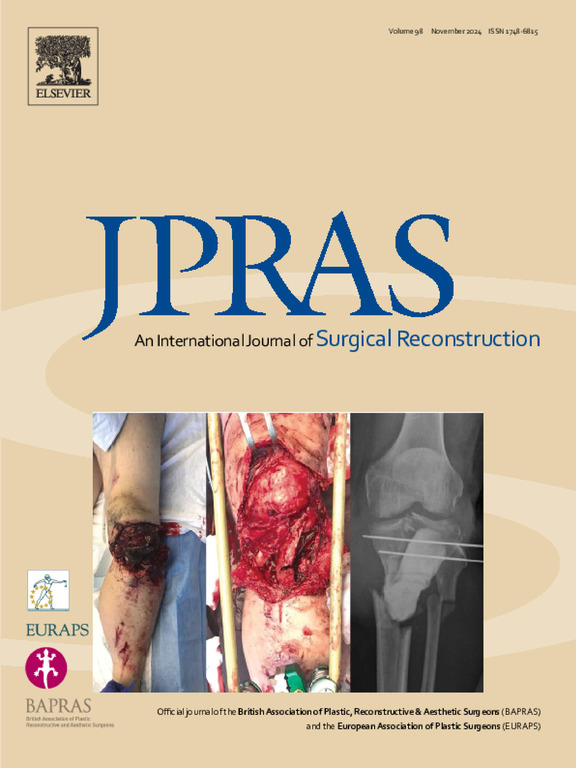非市售PLA/PCL导管与市售PGA和胶原神经导管的上轴突再生治疗大鼠坐骨神经缺损的初步报告
IF 2.4
3区 医学
Q2 SURGERY
Journal of Plastic Reconstructive and Aesthetic Surgery
Pub Date : 2025-07-11
DOI:10.1016/j.bjps.2025.07.005
引用次数: 0
摘要
生物可吸收神经导管作为自体神经移植治疗周围神经缺损的替代方法近年来得到了广泛的应用。到目前为止,两种类型的神经导管已被批准在日本临床使用:聚乙醇酸(PGA)导管和胶原蛋白导管。然而,尚未有研究比较它们在周围神经重建中的疗效。本研究旨在初步比较三种生物可吸收神经导管,PGA和胶原导管以及聚l -乳酸-聚己内酯(PLA/PCL)导管在大鼠坐骨神经间隙模型中的疗效。方法将23只大鼠分为5组:对照组(未处理)、PGA导管组、胶原导管组、PLA/PCL导管组和自体移植物组。根据坐骨功能指数(SFI)的改善和组织学腓肠肌萎缩来评估功能恢复。在治疗12周后,对轴突再生和导管管腔结构进行组织学评价。结果PLA/PCL导管组的功能恢复优于PGA组和胶原组,但略低于自体移植物组。与PGA和胶原蛋白组相比,PLA/PCL组的轴突再生更大,与自体移植物组相当。在PLA/PCL组中,只有内层的管腔被快速吸收,而外层由于降解非常缓慢而保留下来,最终使管腔膨胀。PLA/PCL导管保持腔内稳定性而不会坍塌,不像PGA和胶原导管由于材料降解而显着变窄。结论PLA/PCL神经导管与PGA和胶原神经导管相比,具有较慢的降解速度和较好的管腔结构维持能力,初步表现出较好的轴突再生和功能恢复能力,具有替代自体神经移植物的潜力。本文章由计算机程序翻译,如有差异,请以英文原文为准。
Superior axonal regeneration of non-commercially available PLA/PCL conduits vs commercially available PGA and collagen nerve conduits for the treatment of a rat sciatic nerve defects: A preliminary report
Background
Bioabsorbable nerve conduits have recently emerged as alternatives to autologous nerve grafts in peripheral nerve defects. Two types of nerve conduits have thus far been approved for clinical use in Japan: a polyglycolic acid (PGA) conduit and a collagen conduit. However, no studies have yet compared their efficacy in peripheral nerve reconstruction. This study aimed preliminarily to compare the efficacy of three bioabsorbable nerve conduits, PGA and collagen conduits, and a poly-L-lactide and polycaprolactone (PLA/PCL) conduit, in a rat sciatic nerve gap model.
Methods
Twenty-three rats were assigned to five treatment groups: control (no treatment), PGA conduit, collagen conduit, PLA/PCL conduit, and autograft. Functional recovery was assessed based on improvements in the sciatic functional index (SFI) and histological gastrocnemius muscle atrophy. Axonal regeneration and the luminal structure of the conduits were evaluated histologically 12 weeks post-treatment.
Results
The PLA/PCL conduit group exhibited superior functional recovery compared to the PGA and collagen groups, but slightly inferior results to the autograft group. Axonal regeneration was greater in the PLA/PCL group compared to the PGA and collagen groups, and comparable to the autograft group. In the PLA/PCL group, only the inner layer of the lumen was rapidly absorbed, while the outer layer remained due to its very slow degradation, ultimately allowing the lumen to expand. The PLA/PCL conduit maintained luminal stability without collapsing, unlike the PGA and collagen conduits, which showed significant narrowing due to material degradation.
Conclusion
The PLA/PCL nerve conduit demonstrated superior axonal regeneration and functional recovery preliminarily compared to PGA and collagen conduits, attributable to its slower degradation and superior maintenance of the luminal structure, indicating its potential as an effective alternative to autologous nerve grafts.
求助全文
通过发布文献求助,成功后即可免费获取论文全文。
去求助
来源期刊
CiteScore
3.10
自引率
11.10%
发文量
578
审稿时长
3.5 months
期刊介绍:
JPRAS An International Journal of Surgical Reconstruction is one of the world''s leading international journals, covering all the reconstructive and aesthetic aspects of plastic surgery.
The journal presents the latest surgical procedures with audit and outcome studies of new and established techniques in plastic surgery including: cleft lip and palate and other heads and neck surgery, hand surgery, lower limb trauma, burns, skin cancer, breast surgery and aesthetic surgery.

 求助内容:
求助内容: 应助结果提醒方式:
应助结果提醒方式:


